

| Sherwood's Purple disaster |
| .... |
| For some reading this, then the page title might
perhaps seem overly dramatic and in similar fashion to those headlines
seen everytime a conservation organisation seeks both publicity, and to catch the public's attention - hopefully leading to donations to
the worthy cause. What's the old saying .... any publicity is good
publicity?, or at least words to that effect. But although the title is dramatic, its deliberately meant to be and is a very true and accurate statement of fact in this instance, as despite a very promising start, things ended up looking decidedly unpromising for a good 'Emperor' year in 2023. This page/article looks at the work and findings of Nick and Samantha Brownley and myself on the Purple Emperor butterfly at Sherwood Forest over the course of the Spring and Summer. Its focus is on how a very good flight season for the adults, ultimately lead to a good number of eggs being found, before sun, heat and disaster struck in July! |
 |
|
| I personally feel that it is
important to have these findings documented early and it has come about
by a frustratingly unenthusiastic response towards our data from those
considered to be more knowledgeable on the butterfly. The story of large-scale egg failure within the Sherwood Forest Purple Emperor population, began soon after the first eggs were recorded in July 2022 and news was put out on an 'as it happened' basis of providing those interested with the findings immediately. The original news was excitement at the high number of eggs recorded and the intention was to encourage other recorders to go out and check their local Purple Emperor populations for high egg production rates. But results from elsewhere never came. It seemed no one was looking and it wasn't until the mood of the news being put out changed, as the number of unhatched eggs and lack of larvae we found at Sherwood Forest became seriously low, that some results from elsewhere began to trickle in. By the latter part of September, the few results from both the UK and Europe, mirrored our findings exactly and potentially revealed that egg failure within other Purple Emperor populations wasn't just restricted to the UK. |
||
| ... | ||
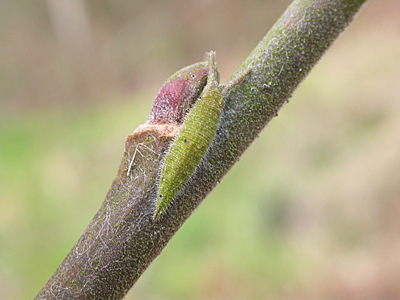 |
The Purple Emperor at Sherwood Forest 2022 The year had started well, with a number of L3 (3rd instar) larvae having been monitored by Nick and Samantha Brownley over the winter months. Nick and Samantha had been constantly surveying for Purple Emperor ovae and larvae over the previous Summer and which they continued to monitor (now as L3 larvae) through the Winter. L3 larvae typically measure around 9-10mm in length. After finding two ovae myself in July 2021, I began my own long search for an over-wintering L3 larva, having never seen one before and certainly not in my home county of Nottinghamshire. I just wanted to see one. I was eventually successful in finding one sat alongside an unopened Sallow bud in February 2022. Searching for larvae at this time of year (while being very useful work) is a rather painstaking and time consuming process, but extremely rewarding when you are eventually successful after a series of fruitless visits and lots of searching on often gloomy, wet winter days. But over the following weeks, Nick, Samantha and myself began combining our efforts and worked together more. It worked brilliantly. |
|
| ... | ||
| Looking for larvae is a great way of
keeping the interest going 12 months of the year, so surveying for the
Purple Emperor in all four life-cycle stages can be a year long process
if wanted. Studying this
butterfly offers the keen recorder that opportunity in a way I very much
doubt other UK
butterflies can. Nick and Samantha's meticulous monitoring work of a number of L3 larva (showed above left) over the winter, proved to be invaluable and a great start to surveying again in 2022. Knowing exactly where over a dozen Purple Emperor larvae were still located and all mostly within reach of the ground, certainly helped when it came to the start of more thorough surveying as the weather warmed and Sallow buds opened. |
| ... |
| Virtually all of the
larvae monitored through the winter, were found resting alongside an
unopened bud, but one was found lying along a scar on a thin Sallow
branch, little more than twice the width of the larva. No larvae have
been recorded to pass the winter in one of the more
traditional manners, such as in the fork of a branch, bark crevice or
fissure and no larval movement was detected or observed until the temperature
started to increase during early 2022. Post-overwintering movement from those larvae monitored over the winter, was largely recorded as short distances (usually less than 30cm), often to a more suitable leaf before feeding resumed, but some larvae which may have moved to other parts of the tree/bush, or were predated, were lost and never relocated despite a great deal of effort on Nick and Samantha's part. Larval predation At least two larvae were known to be lost through instances of predation, which were photographed and documented by the couple on two occasions. Predation among Purple Emperor larvae at any site must be high, as the larvae are continually exposed to the dangers of predation by resting and feeding in full view, on the upper surface of a leaf and although larvae make efforts to deter potential predators, it must fail on occasions. Despite their remarkable camouflage and an uncanny ability to seemingly disappear in front of your very eyes, there must be some degree of parasitisation amongst Purple Emperor larvae here. In the course of searching for larvae, many potential predators and parasitic wasps were observed and larvae must come into contact with these on innumerable occasions over the course of a year. But so far, there have been no recorded instances of parasitisation at Sherwood, which might be surprising with so much continual monitoring. It must happen though. |
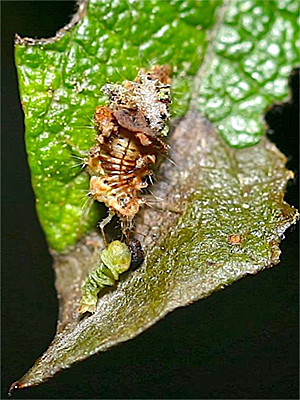 |
|
| Photograph © Nick and Samantha Brownley | ||
| ... |
| Nick and Samantha become increasingly fastidious
in their
recording of the Purple Emperor at Sherwood Forest and this included
taking many photographs to record various events and stages of the
larvae which they were monitoring. One of their photographs showed an L3 (3rd instar) larva partially eaten and there were obviously many suspects, but beetle (possibly Ladybird sp) was strongly suspected. The larva was believed by the couple, to have been dead prior to being found in a partially eaten state, as the head was very dark and not the typical olive/green colour it should have been. The other case of known predation involved an L1 (1st instar) larva, which was found to have been predated by a Lacewing larva and which is showed in the photograph above right. |
| ... |
| Perhaps there is an
overall tendency on an observers part to think that once larvae are large and
robust enough, such as L4 or L5, then the chances of predation and parasitisation
of such larvae lessens.
This is supposedly possible, but as those larvae which successfully
negotiated the winter months developed, many were to go missing again and
suddenly too. This time, larval losses came at a much more unexpected
stage. By the end of May, Nick, Samantha and myself were regularly monitoring a total of 16 larvae, following the finding of a number of new L4 and L5 larvae in the Clipstone Old Quarter area. These larvae represented an extension of the Purple Emperor's known Sherwood Forest range on the range data recorded during 2021. All seemed to be progressing well and following the last of these larva to moult to L5 and with at least one mature larva already becoming a translucent green in the run up to pupation, all five of the Clipstone Old Quarter larvae suddenly disappeared after days (and nights) of close monitoring. The disappearance was baffling and to be honest, it still is. |
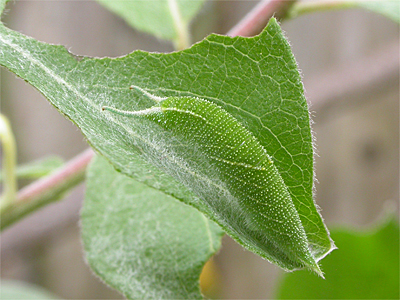 |
|
| ... | ||
| Even though Purple
Emperor larva are sometimes well known to wander away from their
favoured branch to pupate, the fact all five disappeared so suddenly and
were never relocated despite many hours spent searching was a puzzle and
remains unsolved. Even several months later, it still puzzles me every
time I walk past the Sallows they were on. Part of the mystery, was that all but one of those larvae to disappear, weren't anywhere close to preparing for pupation, even though they were all L5 by this time. The moulting and pupation processes both seem rather lengthy in the Purple Emperor to me, especially pupation, which I believe is much longer than in all other UK butterflies I've reared over the years. I'd noticed this after managing to successfully rear a Purple Emperor larvae through to adult at home and which was ultimately released back on site, almost a year to the day of collection back in 2021. |
| ... |
| Map 1:- The distribution of Purple Emperor records (eggs, larvae and pupae) July 2021 - June 2022 | ||
| ... | ||
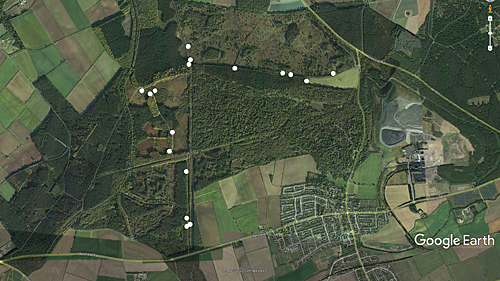 |
But it transpired
that the disappearance of L5 larvae wasn't just confined to those
at Clipstone Old Quarter, as all but two of those L5 larvae being
monitored by Nick and Samantha in other parts of Sherwood Forest were
also inexplicably lost too. Searching continued for a number of weeks and certainly well into the period by which all 16 larvae would have been expected to have reached the pupal stage. As Purple Emperor pupae are known to strongly flouresce under UV light, a series of nightly searches were carried out during June. All those Clipstone Old Quarter Sallows, on which larvae had been recorded were checked every night during Glow Worm surveys I carried out, but there was nothing. All nearby foliage was checked in the hope that perhaps larvae had wandered off the host tree. In the end, just two larvae out of 16 were proved to have pupated successfully. |
|
| ... | ||
| The above image shows the positions
of all known Purple Emperor larvae found in the Sherwood Forest CP,
Budby South Forest and other areas during the course of 2021 and early
2022. The majority of the records came from Nick and Samantha Brownley,
as they continued their work from 2021 into the spring of 2022. It was
after I had eventually found my first L3 in the February, that I began
to become more drawn in by this butterfly's somewhat mythical status,
which seems to have become driven by recent literature dedicated to what
is without any doubt, a
truly handsome and large butterfly. I not only started to contribute some records and data, but also encouraged Nick and Samantha to start and put their findings/dates etc down on paper more. Ater all, a record is nothing while ever it's in someone's head. In the end, WhatsApp proved to be an invaluable tool in our exchanging data quickly and easily across different parts of the forest, despite a mostly dreadful mobile reception. |
||
| ... | ||
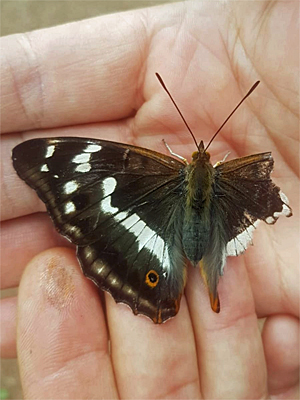 |
The Purple Emperor flight season 2022 Gathering together all records of ovae and larvae from 2021, then superimposing them onto a Google Earth image of Sherwood Forest, showed that Purple Emperor distribution was significantly more widespread than had been initially thought. Indeed, for someone recording the invertebrates of Sherwood Forest since 2008, it was barely even conceivable that we were even gathering records and compiling maps of this butterfly in Sherwood Forest at all. It was completely unexpected and would have been totally out of the question just a few years ago, because there had been no published records of Purple Emperor from the Sherwood Forest area for well over a century. Yet it turned out that there had been records all the time, it was just that very few people were party to them at the time and it seems they were never made freely available, unless they only came to light only very recently. Even Natural England East Midlands and Nottinghamshire County Council, the former manager of the Sherwood Forest Country Park, never knew anything of the records. Had those records been made available, then maybe we'd have 20 years of monitoring to write about now, instead of just two? And it should be remembered that all this excitement about the Purple Emperor at Sherwood Forest, only came about after the chance finding of a two-winged Purple Emperor by Nick and Samantha back in 2020. The butterfly had most likely been accidentally run over by a mountain bike while taking minerals and salts from the forest track, with wings open. That seems the most likely reason as to how a butterfly could lose two wings and yet somehow remain alive. |
|
| Photograph © Nick and Samantha Brownley | ||
| ... | ||
| Despite the disappointing number of larvae making it through to adult by the end of June 2022, the number of records accumulated was still thought to represent an overall success in monitoring the Purple Emperor at Sherwood Forest and so the 2022 flight season was eagerly awaited, even after the disappointment of losing most of the known L5 larvae across the site. | ||
| ... | ||
| 'Empy' the now well known Purple Emperor larva featured on a number of
occasions on the 'Ramblings of an entomologist' YouTube channel,
eventually hatched out as a female and was released back at the point of
collection in Sherwood
Forest on a sunny June 22nd morning. While being reared at home, the larva was always kept outside in all weathers and given only minimal protection (placed under a patio table) from the very worst of the weather. This is the only method of ensuring that captive Purple Emperor larvae have greater success at over-wintering. They have to be kept outside at all times. At one point, I did begin to suspect that despite all efforts to avoid it, this larva may have become slightly more advanced in development than those L3 larvae being monitored in the wild at the time. Thankfully, it proved not to be the case and I was pleased that in the end I had not contributed to any such advancement of larval development. But the rearing of this larva proved invaluable, as it's release in the adult state gave us a very accurate idea of when to start looking for adults and a better idea of when the first eggs might be found. A cool, but mostly dry first few months of the year, eventually led to a warm and dry spring. This helped bring forward the Purple Emperor flight season and butterflies were expected by some authorities to be on the wing before the end of June. That fell in line with a number of other butterflies flying early this year and certainly proved to be correct. Although the first Sherwood Forest record wasn't recorded by Nick and Samantha Brownley until July 1st, it was obvious that the first Purple Emperors must have been out before the beginning of July - probably within days of the release of 'Empy' on June 22nd. Other records soon followed and butterflies were found in a number of locations where they had been recorded from in 2021. But there was confirmation of the butterfly's wider ranging across this part of Sherwood Forest, as records were obtained from several new areas, confirming an expansion of its local range, or perhaps just confirmation that it still occurred in areas it has occupied for years?. Even though adult Purple Emperors were not seen during monitoring work in some of the areas used the previous year, searching for ovae in July provided a more accurate overview of the butterflies actual range, at least certainly in the case of the more wide-ranging females. |
|
|||||||||||||||||||||||||||||||||||||||||||||||||||||||||||||||||||||||||||||||||||||||||||||||||||||||||||||||||||||||||||||
| ... | ||||||||||||||||||||||||||||||||||||||||||||||||||||||||||||||||||||||||||||||||||||||||||||||||||||||||||||||||||||||||||||||
| Females fly at some speed along forest tracks, often within four or five feet of the ground and they are difficult to follow with the eye. Sallows situated along forest tracks, will in most cases be visited by female Purple Emperors in turn and if searched thoroughly and several times, then eggs will most likely be found. | ||||||||||||||||||||||||||||||||||||||||||||||||||||||||||||||||||||||||||||||||||||||||||||||||||||||||||||||||||||||||||||||
| .... | ||
| Map 2:- The distribution of Purple Emperor records (eggs and larvae) July 2022 - September 2022 | ||
| Searching for eggs
requires time, effort, experience and patience. It is not an easy task
and the rate of eggs found/per hour spent searching is fairly low, but
having two or three people searching helps. So now fuelled by a greatly increased interest in the butterfly which I hadn't initially planned on having, I started to help Nick and Samantha in their search for eggs, after they found three on the first Sallow they started searching on July 14th. One of these eggs was noted to be extremely close to hatching and had indeed hatched successfully the following morning. The larva wasn't refound on other visits though, although nothing untoward was suspected immediately. Nick and Sam had found that larvae were prone to wander some distance from their favoured leaf in search of another and larvae do become harder to locate once they're L2 instar and older. |
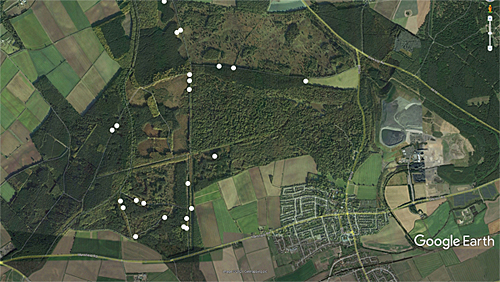 |
|
| .... | ||
| The Sallow these first eggs were
on, was a tree on which eggs had been recorded a year prior and within a
matter of days, most of those Sallows producing eggs and larvae in 2021
were again yielding between one and three eggs. In just over a week and
after a great amount of effort, some 39 eggs and one L1 (1st instar)
larva had been located, with another L1 larva recorded post-hatching
from the egg. All was looking extremely promising and once the
locations of both eggs and larvae were plotted, it showed how the
butterfly's range had expanded on the previous year. Even though Dilys and myself never looked for, or saw, Purple Emperor here at any time since we started our association with the Sherwood Forest back in 2008, and regularly (often daily) covered all those areas it the butterfly been found in since 2020, we never once recorded the butterfly. But based on the latest information we had available to us at the time, we would never have considered looking. And despite the fact that we never saw it, I personally think its been in all the areas we now associate the butterfly with, all the time. I'm not convinced there has been any significant localised range expansion within the confines of the area showed on the above maps at all, rather that it's just that we're now more aware and purposely looking for it on a regular basis twelve months of the year. |
||
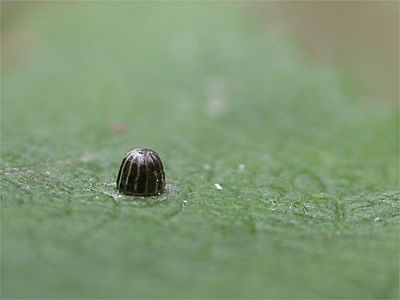 |
Egg loss July was notable for the weather, in particular, its extremes of weather. Not only was it still dry, but it had started to become exceptionally so and the temperature soared to record levels for many parts of the UK. It just about officially got to 40ºC in the shade over some parts of Nottinghamshire, so you could probably add another 10ºC or 15ºC on that in direct sun and therein lies the transformation in fortunes of the Purple Emperor in 2022. From what had been such an exciting few weeks watching a female Purple Emperor after just having dried its wings, males flying in the tree canopy and at lower levels, finding record numbers of eggs and then ...... to watch those eggs remain as eggs day after day. Why weren't they hatching? The day time temperatures were excessively hot and late one morning when I was returning home, I called in at Clipstone Old Quarter to secure two eggs I'd managed to locate on July 15th with the intention of rearing them at home. Whether or not you agree with removing eggs or larvae from the wild (known from this point on as 'trevving' by this time) and to rear them on at home, is dependant on the individual's viewpoint regarding the matter. |
|
| Unhatched Purple Emperor egg, Clipstone Old Quarter September 2022 | ||
|
Any eggs I take to
rear on, are eventually released back on site, either as full-grown larvae, pupae,
or adults at a later date, so no local population genetics are ever
removed from a local colony. But again, wanting to rear was something which paid off, by
providing us with the first
hint something was dreadfully wrong. Of the two eggs I took, one was a few days more developed that the other and the larva's head was already starting to darken. It continued to darken over the next two days and on the day it was expected to hatch, it didn't. Both eggs were kept indoors, out of the sun and continuously monitored. On hatching, they were to have been transferred to a potted Sallow outdoors and placed in pretty much full shade. But it became obvious that egg development stopped for some reason. The abnormally high temperatures which the remaining 37 eggs in Sherwood Forest had to withstand, would have been especially excessive for those eggs positioned on foliage taking direct sun for any length of time. But most of the eggs Nick, Samantha and myself had found, did indeed fall into that category. It was a worry and I did think that maybe the two eggs I had at home, had perhaps failed due to the heat in the house at the time? On August 3rd, I made a return visit to Clipstone Old Quarter, as back on July 15th, I'd found a third Purple Emperor egg, high up a rather straggly Goat Sallow growing at the side of a small path and which I now wanted to check on. The Sallow was growing for it's most part in shade, so I was delighted to soon locate the resulting (now) L2 larva, fairly close to to where the egg had been laid. This find immediately indicated that there must be some chance of success for those eggs which had been laid in shadier locations. But later monitoring by Nick and Samantha, soon revealed that there had been widespread egg failure across Sherwood Forest and word was immediately put out to interested parties. However, our findings and concerns were met with a more or less total lack of response and seeming uninterest in the findings. After further mention of the egg failure and subsequent lack of larvae, a handful of reports started to be come in from other recorders finding similar high mortality rates at their own sites for the butterfly. Then a report from Europe came in and confirmed our original findings. This was clearly a wide-scale failure for the Purple Emperor and not just restricted to the UK. |
||
|
Nick and Samantha's
August surveys produced just one L2 larva towards Blackpool Plantation
and numerous unhatched, now dead eggs. There were no signs of some eggs
but to be fair, remembering the exact location of almost 40 eggs is impossible, but it was
considered likely that of the 39 eggs located in 2022 - all but
two failed. There is though, always some hope. Invertebrate populations either local to a single site, county wide or nationally, will vary considerably over the course of a number of years. Dilys and I had noticed years of abundance within some shieldbug and ladybird populations locally in the past and butterflies are no exception to such variances in numbers. At some point a population reaches its period of abundance and for whatever reason e.g. excessive parasitisation, climatic conditions etc, that population declines, often drastically and certainly noticeably. In this instance, the high rate of egg failure has to be put down to the extremity of the dryness and high temperature, but the breeding season had obviously been a successful one before the real heat arrived. |
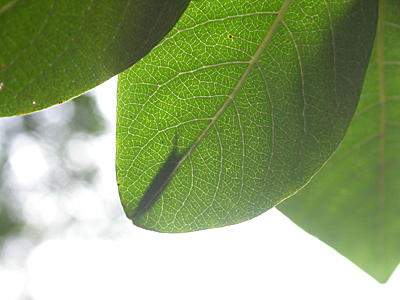 |
|
| .... | ||
|
The failure of most
of the eggs was disappointing to say the very least and not just because
of the amount of effort that had been put in to secure such a total. It
meant that during August and September, it was difficult to become
motivated enough to go out and look for L2 and L3 larvae. After all, any
success would largely be reliant on having originally missed eggs or L1
larvae within easy reach of the ground a month or so prior, or in the
seemingly faint hope that perhaps more eggs had survived the heat than
now seemed likely. But there was always the possibility that eggs laid
higher up towards the centre of Sallows, may have escaped the worst of
the heat. On September 10th, I made an effort to check for larvae around Clipstone Old Quarter. I was checking Sallow leaves from underneath, viewing them against the bright sky and hoping to pick out the silhouette of L3 larvae that way. Despite finding it a slightly quicker method of viewing foliage, it proved fruitless until late in the visit when I eventually saw the distinctive silhouette of an L3 larva sat at the tip of a leaf. It was just over seven feet off the ground in one of several large Sallows. At last, there was some success and hope. Nick and Samantha surveyed for larvae again in the latter part of September and managed just a single L3 larva from Clipstone Old Quarter on September 24th. It was located some ten feet up and in a tree which had been thoroughly checked by myself (so I thought) a fortnight earlier. |
||
| ... | ||||||||||||||||||||||||||||||||||
|
They are so
easy to miss. This particular Sallow had a number of eggs on it (all at
waist height) in July, but whether this larva originated directly from
one of these eggs is difficult to tell. So at the beginning of September, the summary of the gathered data read 39 eggs and one L1 larvae found, but by the end of the month, of those 39 eggs and larva - only two larvae were known to have successfully made it to the end of the month (more about one of those shortly). Later surveys did produce another two L3 larvae, so by September 30th, we knew of just four larvae. |
|||||||||||||||||||||||||||||||||
| ... | ||||||||||||||||||||||||||||||||||
|
Although in the end a
disastrous season, there is all likelihood that larvae will have
survived in sufficient numbers to produce adults in 2023. No matter how
much time is devoted to surveying for the eggs and larvae of this super
butterfly, there is a limit to any total that can be found and only
those within easy reach, or by scanning from the
ground with binoculars will be found and that must represent a small percentage of the
total. .... and an L6 larva But before ending this round-up of the Purple Emperor's rather season at Sherwood Forest, documentation must be made of the developments concerning the L2 larva I took home on August 3rd. Initially everything seemed fine and the moult to L3 took place on August 20th. This was normal and expected. However, a sudden moult to L4 on September 1st wasn't and neither was a moult to L5 a week later on September 8th. Over-wintering is as L3 larvae measuring about 10mm in length, but by now this larva was already larger, although growth was slow and feeding seemed limited for this stage. Needless to say there was a degree of interest showed by others in this unusual event and there have been a handful of other instances of this happening in captivity before. But it seemed that when there was a further moult to L6 on the evening of September 26th, that's where any interest from those who should have an interest in such matters appeared to end. Despite having all the moult dates, it seems that this occurrence isn't believed, or has been taken lightly and with a pinch of salt. Personally I think this is something of a shame and somewhat disappointing, as aren't naturalists meant to be inquisitive and have open minds? But if something is scientifically unknown, that doesn't mean it doesn't happen does it? But there was clearly something wrong with the make up of this particular larva, as despite witness to it having moulted five times to L6 instead of the traditional four moults to L5, it's eating habits were always rather poor. It eventually died rather suddenly on September 30th, after eating a little before wandering away from its favoured leaf and off the plant it was on. It was found among dead leaves at the base of the plant later that day. Maybe there was some error in this particular larva's genetic make up, or maybe it was something triggered by the extremity of July's heat. We'll never know I suppose? But could such behaviour have something to do with the reason why so many L5 larva disappeared way back in June? That's another question to which the answer would be worth finding .... maybe a question for someone with an inquisitive mind? |